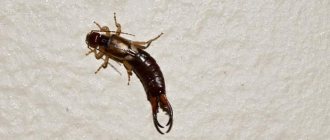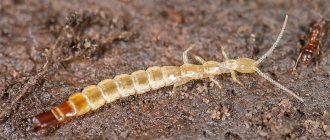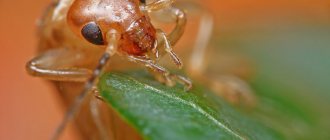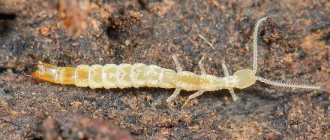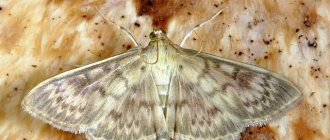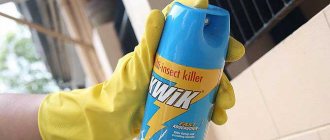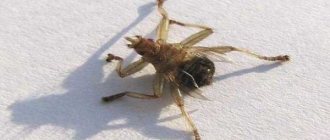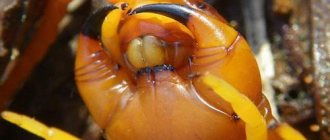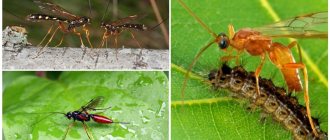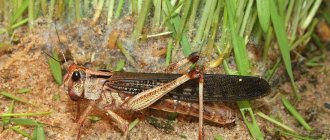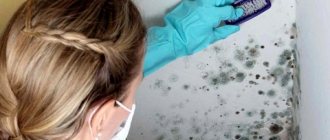- Wild animals
- >>
- Insects
The earwig is a predatory insect with omnivorous feeding habits, which sometimes lead to significant damage to some commercial crops. Most often, they contaminate vegetables by getting inside them. However, they can be useful in some cases due to their predatory habits. The name refers to the legend that it can crawl into a person's ear and gnaw through the eardrum. It is curious that such an explanation is also available in the English-speaking segment. However, such cases have not been recorded.
Origin of the species and description
Photo: Earwig
The earwig survives in a wide range of environments and is a fairly common house insect. Today, the name earwig (in English earwig) is interpreted as referring to the appearance of the hind wings, which have features unique and characteristic of these insects and resemble a human ear in an expanded form. The species name is a specific reference to this feature.
The earliest fossils of earwigs date back to the end of the Triassic period. A total of 70 specimens were found. Some anatomical features of modern earwigs are not found in the earliest fossils. Their claws did not bend completely, like those of modern representatives. Ancient insects looked like modern cockroaches. Their trace was lost in the sediments of the Permian period. Representatives of this group are not found in the Triassic period, when the evolutionary transition from Protelytroptera to earwigs may have occurred.
Video: Earwig
Archidermaptera is thought to be sister to the remaining groups of earwigs, the extinct group Eodermaptera and the living suborder Neodermaptera. The extinct suborders have tarsi with five segments (as opposed to the three found in Neodermaptera), as well as unsegmented cerci. No fossils of Hemimeridae and Arixeniidae are known. Like most other epizootic species there are no fossils, but they are probably no older than the late Tertiary.
Some evidence of early evolutionary history is the structure of the antennal heart, a separate circulatory organ consisting of two ampoules or vesicles that are attached to the frontal cuticle at the bases of the antennae. These features have not been found in other insects. They pump blood through elastic connective tissue rather than muscles.
Is it dangerous for humans?
Earwig: why is it dangerous to humans? All the chilling stories about the insidiousness of the two-tailed bug, which can destroy a person by penetrating his ear and damaging his brain, are nothing more than fiction.
Of course, she can crawl into the ear of some summer resident if he suddenly wants to take a nap right on the ground. What happens if an earwig gets into your ear? The insect does not pose any danger to the ear and brain.
In this case, you should not panic, but, if possible, immediately consult a doctor and he will remove the unfortunate bug from the outside.
IMPORTANT! The earwig is not poisonous. It is impossible to die from its bite. An insect can only bite in defense if it suddenly sees you as a source of danger. The bite site may turn red, in which case the skin must be treated with an antiseptic.
Appearance and features
Photo: What an earwig looks like
Earwigs are brownish-red in color and have elongated bodies ranging from 12 to 15 mm in length. They are equipped with 3 pairs of legs that are yellowish-brown in color. The elongated, flattened brownish body has a shield-shaped front back. The insect has two pairs of wings and thread-like antennae about 12–15 mm long. Adult males vary in body mass and head width. Common earwigs are known for the set of pincers that protrude from their abdomen and are used for protection and in mating rituals.
The forceps show sexual dimorphism, with males being strong, longer and more curved than females. Women's forceps are about 3 mm long, less durable and straight. The European earwig has two antennae, 14 to 15 segments long, which contain many important sensory organs, as well as a fully developed set of wings.
The long, segmented filaments are used during mating, feeding, and self-defense. Females also have a tegmena about 2 mm in length. The hind wings are membranous, wide with lobular veins. The earwig stays almost vertical in flight. When folding its wings together, the insect folds them twice. Despite its rather developed wings, the earwig uses them extremely rarely, preferring to move on its limbs. The legs are of a running type and consist of three segments.
Internal structure
The exact internal structure of the two-vostok has not been established. Insects have a highly developed nervous system; they have many nerve endings throughout the body - on the limbs, posterior cerci, antennae.
Therefore, they are able to sense the approach of danger from a great distance, the same applies when catching prey.
The respiratory organs of earwigs are the trachea. Air enters them through holes located on the sides of the body - spiracles. The inside of the trachea is lined with a thin chitinous film, which has a spiral thickening.
It gives the trachea elasticity and prevents them from flattening. The intake and removal of air is carried out by changing the volume of the abdomen through muscle contraction.
Where does the earwig live?
Photo: Earwig in Russia
Earwigs are native to Europe, East Asia and North Africa. Today they can be found on every continent except Antarctica. The geographic range of the species continues to expand. They have even been found on the island of Guadeloupe in the Pacific Ocean. In Russia, the earwig is seen east to Omsk and in the Urals, and in Kazakhstan, the range extends to the Volga interfluve, south to Ashgabat, including the Kopetdag Mountains. The earwig was introduced to North America in the early twentieth century and is now common across much of the continent.
Fun fact: In North America, the earwig has two related subspecies that are reproductively isolated. Populations in cold climates generally have one clutch per year, producing species A, while populations in warmer climates have two clutches per year, producing species B.
European earwigs are terrestrial organisms that live primarily in temperate climates. They were originally discovered in the Palearctic and are most active when daytime temperatures have minimal fluctuations. The insects are found over a very wide geographic range and at altitudes up to 2824 m. During the day, they prefer places that are dark and damp to hide from predators.
Their habitat includes forests, agricultural and suburban areas. During the mating season, females prefer nutrient-rich habitats as a place to burrow and lay eggs. Hibernating adults can tolerate cool temperatures, but their survival is reduced in poorly drained soils such as clay. To avoid excess moisture, they tend to the south side of the slopes. Sometimes they also occupy the hollow stems of flowers.
Life cycle
The type of development of the earwig is called incomplete metamorphosis. In a year it is able to live through all stages of development - egg, larva, adult. The female is capable of laying 30-50 eggs at a time. The incubation period is 56-80 days.
At the end of this period, larvae appear, and only then individual earwigs gradually form.
Life expectancy is 1 year; during this period, the female is capable of producing several clutches of eggs.
What does an earwig eat?
Photo: Common earwig
Earwigs are active mainly at night. This insect is an omnivore, feeding on a variety of plant and animal matter. Although the insect's predatory habits are somewhat compensated by eating plant matter, they can sometimes cause significant damage to vegetables, fruits and flowers. Beans, beets, cabbage, celery, cauliflower, cucumber, lettuce, peas, potatoes, rhubarb and tomato are among the vegetable crops that are under attack. Although earwigs are considered scavengers and predators. They feed with their chewing mouthparts. They are known to feed on:
- aphids;
- spiders;
- larvae;
- mites;
- insect eggs.
Their favorite plants are:
- white clover (Trifolium repens);
- medicinal grasshopper (Sisymbrium officinale);
- dahlia (Dahlia).
They also like to eat:
- molasses;
- lichens;
- fruits;
- fungi;
- algae.
These insects prefer to eat meat or sugar rather than natural plant material, although plants are the main natural food source. Earwigs prefer aphids to plant material. Adults eat more insects than young ones. Among the flowers most often injured are dahlias, carnations and zinnias. Damage to ripe fruits such as apple, apricot, peach, plum, pear and strawberry is sometimes reported.
Although earwigs have well-developed wings, they are excessively weak and rarely used. Instead, earwigs use people's clothing, commercial goods such as lumber, ornamental shrubs, and even bundles of newspaper as their primary mode of transport. They often consume vegetables and animal matter in equal proportions.
Harm from earwigs
Earwig: A useful enemy.
Insects chew through plants and leave holes in the leaves. The earwig feeds on the pulp and stems. Black dots form on the foliage. They can be located in outbuildings with grain crops and cause damage to them.
Insects crawl into the hive and eat honey and bee bread. They are capable of destroying the root system of ornamental and fruit crops. The earwig poses a danger to poppies, asters, dahlias, and phlox. Spoils indoor flowers.
Tangible benefits
Despite the enormous amount of harm, insects feed on invertebrates - aphids and spider mites. Thus, they save many crops from pests. They also remove rot by eating overripe or fallen fruits.
The name “earwig” evokes terrible thoughts about how human ears suffer. But this is a myth that has no confirmation. They may bite, but such a wound will cause no more than mild discomfort.
Features of character and lifestyle
Photo: Earwig insect
Earwigs are nocturnal. They hide during the day in dark, damp places such as rocks, plants, huddles, fruits, flowers and other similar places. They emerge at night to hunt or gather food. They are weak flyers and therefore move mainly by crawling and being carried by humans. Earwigs can be considered either solitary or colonial insects. During the mating season, females live alone, but during other months of the year they tend to gather in very large groups.
Earwigs are considered a subsocial species because they provide parental care to their children. When common earwigs feel threatened, they use their pincers as weapons to defend themselves. Adult earwigs release a pheromone that attracts other earwigs. Nymphs also release pheromones that entice mothers to care for them. The tongs are also used as a means of communication during mating and exhibit threatening behavior.
The nighttime activity of earwigs depends on the weather. Stable temperatures stimulate activity, but extremely high temperatures are discouraged. High relative humidity suppresses movement, while higher wind speeds and greater cloud cover stimulate earwig activity. They produce an aggregation pheromone in their excrement that is attractive to both sexes and nymphs, and secrete quinones as defensive chemicals from abdominal glands.
Methods to combat earwigs
Despite all the benefits of the insect, if there are a large number of individuals on the site, you need to get rid of them. Some tips for fighting:
- remove stale hay, straw, leaves and firewood from the area;
- carry out deep digging for the winter;
- set traps;
- for bait, put 2 boards with wet rags and leaves;
- pour boiling water over the intended areas;
- all cracks in the apartment are sealed, leaks are eliminated;
- periodically inspect indoor plants;
- lay out sponges soaked in vinegar;
- Insecticides are added to baits.
Social structure and reproduction
Photo: Earwig in the garden
Earwigs usually mate in September, after which they can be found underground in burrows. Courtship rituals involving pincers play a large role in the mating process. Males wave their tongs in the air, stroking and grabbing the female. However, forceps are not used in the actual mating process. If the female approves of the male's advances, he turns his abdomen into a mating position and attaches himself to the female. During mating, females move around and feed with the male attached to her abdomen. Fertilization of the eggs occurs inside the female. Sometimes during mating, another male will come and use his tongs to fight off the mating male and take his place.
Fun Fact: Earwigs typically breed once a year from September to January. In late winter or early spring, females lay 30 to 55 eggs in a burrow dug in the soil. The offspring become independent two months after hatching and no longer require parental care. Earwigs reach sexual maturity at 3 months and can breed as early as the following season.
Females overwinter about 5-8 mm underground with their eggs, guarding them and keeping them clean from fungi and other pathogens using their mouths. Males are driven out of the hole in late winter or early spring, and the female lays fertilized eggs. When the larvae hatch after 70 days, the mother provides protection and food by belching.
When they become second instar nymphs, they emerge above ground and find their own food. However, during the day they return to their hole. Nymphs of the third and fourth instars live above ground, where they develop to adulthood. Nymphs are similar to adults, but are lighter in color with smaller wings and antennae. As nymphs progress from one instar to the next, they begin to darken, their wings grow, and their antennae gain more segments. Between each stage of development, the young molt, losing their outer cuticle.
Danger of insects
Many people are interested in why the earwig is dangerous for people, but it is practically incapable of causing harm to human health. The insect may sometimes bite, and people with allergic reactions may be more sensitive to its bite.
The stinger is not a poisonous creature, and the liquid that it injects at the time of the bite is not poison, it is a specific aromatic substance.
If it was not possible to avoid a bite from this insect, then the affected area can be treated with an antiseptic agent. You can also take an additional antihistamine.
The danger of earwigs can only be to crops. If a large number of these insects live in a vegetable garden or garden, then they can significantly damage trees, seedlings, flowers, fruits, vegetables and other vegetation.
Natural enemies of the earwig
Photo: What an earwig looks like
The earwig is preyed upon by several species of Diptera, as well as Coleoptera beetles. The main enemies are ground beetles such as Pterostichus vulgaris, Poecilopompilus algidus, forest ground beetles and Calosoma tepidum, as well as flightless beetles (Omus dejeanii). Other predators include toads, snakes, and some birds. The earwig has several different defense mechanisms used to avoid predation. These include using forceps as weapons and using glands found on the abdomen to release chemicals that emit a foul odor and act as a repellent to predators.
The most famous predators of earwigs include:
- ground beetles;
- beetles;
- wasps;
- toads;
- snakes;
- birds.
Earwigs are hosts for a variety of parasitic organisms. They also serve as predators of other insect species such as aphids and some protozoans. Earwigs are important scavengers in the ecosystem, eating almost anything that is edible. Earwigs can help control aphid populations, thereby reducing the number of crops destroyed by pests.
Because earwigs tend to hide in dark, damp places, they often find their way into homes. These insects are practically harmless to humans, but their unpleasant smell and appearance make them undesirable guests in the house. They can also damage fruits and other crops as they feed on them.
In addition, the earwig causes significant damage to crops, flowers and orchards when populations are high. Some of the commercially valuable vegetables it eats include cabbage, cauliflower, celery, lettuce, potatoes, beets and cucumber, among others. They readily consume corn tassels and can damage the crop. They damage young plum and peach trees in early spring when other food is scarce, devouring flowers and leaves at night.
Nutrition
These insects are unpretentious and omnivorous. Favorite foods are fruits, vegetables, plants, especially garden flowers.
They do not disdain the remains of small insects. Often, in search of food, they can crawl into a residential building, where they feed on food scraps from the table, destroy indoor plants, and can crawl into a wardrobe and damage clothes.
Earwigs do not like daylight and crawl out in search of food at night. During the day they gather in a group under the bark of trees, in the cracks of boards, under stones, preferring dark and damp shelters.
In homes they can be found in bathrooms , toilets , and basements .
Notes[ | ]
- ↑ 12
Leatheroptera / Ryazanova G.I. // Kireev - Congo. - M.: Great Russian Encyclopedia, 2009. - P. 415. - (Big Russian Encyclopedia: [in 35 volumes] / chief editor Yu. S. Osipov; 2004-2017, vol. 14). — ISBN 978-5-85270-345-3. - ↑ 12
Biological encyclopedic dictionary / Ch. ed. M. S. Gilyarov; Editorial team: A. A. Baev, G. G. Vinberg, G. A. Zavarzin and others - M.: Sov. encyclopedia, 1986. - P. 268. - 831 p. — 100,000 copies. - Bey-Bienko G. Ya.
Leatherwing insects. [Fauna of the USSR. Vol. 5]. - M.-L.: Publishing House of the USSR Academy of Sciences, 1936. - 240 p. - Life of animals. 2nd ed. T. 3. Arthropods, Trilobites, Chelicerates, Tracheinophytes, Onychophora. Ed. M. S. Gilyarov and F. N. Pravdin. - M.: Education, 1984. - 464 p. — Circulation 300,000 copies.
- Ross G., Ross C., Ross.
D. Entomology. Per. edited by G. A. Mazokhina-Porshnyakova. - M.: Mir, 1985. - 576 p. — Circulation 10,000 copies. - Kluge N. Yu.
Modern taxonomy of insects. Principles of taxonomy of living organisms... - St. Petersburg: Lan, 2000. - 336 p. - Robert G. Foottit, Peter H. Adler.
Insect Biodiversity: science and society. - Blackwell Publishing Ltd, 2009. - P. . — 642 p. — ISBN 978-1-4051-5142-9. - Zhang Z.-Q.
"Phylum Athropoda". — In: Zhang Z.-Q. (Ed.) “Animal Biodiversity: An Outline of Higher-level Classification and Survey of Taxonomic Richness (Addenda 2013)” (English) // Zootaxa / Zhang Z.-Q. (Chief Editor & Founder). - Auckland: Magnolia Press, 2013. - Vol. 3703, no. 1. - P. 17-26. — ISBN 978-1-77557-248-0 (paperback) ISBN 978-1-77557-249-7 (online edition). — ISSN 1175-5326. - Friedrichsen, G.W.S.;
Robert W Burchfield. The Oxford Dictionary of English Etymology / Onions CT. - 1996. - United Kingdom, Oxford University: Oxford University Press, 1966. - P. earwig. — ISBN 978-0-19-861112-7. - Invertebrates: should we be afraid of them? (unspecified)
(inaccessible link). Access date: December 6, 2013. Archived September 9, 2014. - Harmless ticks
- ↑ 1 2 Gillott, Cedric.
Entomology (undefined). - 3. - Dordrecht: Springer, 2005. - pp. 175-179. — ISBN 978-1-4020-3184-7. - Nakata S., Maa T.C. 1974. A review of the parasitic earwigs (Dermaptera: Arixeniina; Hemimerina). Pacific insects 16
: 307–374. - Powell, Jerry A.
Dermaptera // Encyclopedia of Insects (unspecified) / Resh, Vincent H.; Cardé, Ring T.. — illustrated 2nd. - Academic Press, 2009. - P. 1132. - ISBN 978-0-12-374144-8. - Eisner, Thomas;
Rossini, Carmen; Eisner, Maria. Chemical defense of an earwig (Doru taeniatum) (undefined) // Chemoecology. - 1941. - T. 10, No. 2. - P. 81-87. - doi:10.1007/s000490050011. Archived from the original on July 14, 2011. - Jarvis, Karl J.;
Haas, Fabian; Whiting, Michael F. Phylogeny of earwigs (Insecta: Dermaptera) based on molecular and morphological evidence: Reconsidering the classification of Dermaptera (English) // Systematic Entomology : journal. - Wiley-Blackwell, 2005. - Vol. 30, no. 3. - P. 442-453. - doi:10.1111/j.1365-3113.2004.00276.x. - Kocarek, Peter;
John, Vaclav; Hulva, Pavel. When the Body Hides the Ancestry: Phylogeny of Morphologically Modified Epizoic Earwigs Based on Molecular Evidence (English) // PLOS ONE: journal. — 2013. — Vol. 8, no. 6. - P. e66900. - doi:10.1371/journal.pone.0066900. - Bibcode: 2013PLoSO...866900K. - Grimaldi, David;
Michael Engel. 7 // Evolution of the Insects (undefined). - 1. - Cambridge University: Cambridge University Press, 2005. - pp. 217-222. - (Cambridge Evolution Ser.). — ISBN 0-521-82149-5. - Fabian Haas.
Dermaptera - Earwigs (undefined). — Tree of Life web project. - Engel, Michael A.;
Jong-Deock Lim, Kwang-Seok Baek, and Larry D. Martin. An Earwig from the Lower Cretaceous of Korea (Dermaptera: Forficulina) (English) // Journal of the Kansas Entomological Society: journal. - 2002. - Vol. 75, no. 2. - P. 86-90. - Gordh, George;
David H. Headrick. A Dictionary of Entomology (undefined). - CABI Publishing, 2003. - ISBN 0-85199-655-8. - Pass, Günther;
Hans Agricola, Heiner Birkenbeil, and Heinz Penzlin. Morphology of neurons associated with the antennal heart of Periplaneta americana (Blattodea, Insecta) (English) // Cell and Tissue Research: journal. - Springer Berlin / Heidelberg, 1988. - August (vol. 253, no. 2). - P. 319-326. - ISSN 0302-766X. — PMID 3409288. (inaccessible link) - Nation, James L.
11: Circulatory System // Insect physiology and biochemistry (undefined). - 1. - CRC Press, 2001. - P. 310. - ISBN 0-8493-1181-0. - Wan X., Kim MI, Kim MJ, Kim I. 2012. Complete mitochondrial genome of the free-living earwig, Challia fletcheri
(Dermaptera: Pygidicranidae) and phylogeny of Polyneoptera.
PLoS One 7
(8):e42056. doi:10.1371/journal.pone.0042056. - ↑ 1 2 Burton, Maurice.
International Wildlife Encyclopedia (unspecified). - 3. - Marshall Cavendish Inc, 2001. - ISBN 978-0-7614-7266-7. - Robinson, William H.
Handbook of urban insects and arachnids (unspecified). - Cambridge, UK: Cambridge University Press, 2005. - P. 480. - ISBN 978-0-521-81253-5. - Marshall, Stephan A.
4 // Insects: Their Natural History and Diversity: With a Photographic Guide to Insects of Eastern North America. — Buffalo, NY; Richmond Hill, Ontario: Firefly Books, 2006. - P. 63-64. — ISBN 978-1-55297-900-6. - Cranshaw, W. S.
European Earwigs
(unspecified)
.
5.533
. Colorado State University (January 2007). Access date: June 25, 2009. - Description neg. Earwigs (Dermaptera) (undefined)
(inaccessible link). Access date: July 10, 2013. Archived January 30, 2013.
Description[ | ]
The body length is 7–50 mm[12]. The fore wings are hard and greatly shortened (turned into hard, leathery elytra), the hind wings are membranous, but wingless forms also exist. At the end of the abdomen there are appendages in the form of a pair of mites (cerci). They are moisture-loving and heat-loving, and are predominantly nocturnal. They feed on detritus (organic remains of animals and plants).
Known external parasites ( Arixenia esau
) bats (
Cheiromeles torquatus
), and predators (
Arixenia jacobsoni
) feeding on insects inhabiting the guano of bats (these earwigs are classified into a special suborder Arixeniina).
Hemimeridae (Hemimerina, 7 species of the genus Hemimerus
, Africa) parasitize the skin of the hamster rat (
Cricetomys gambianus
).[13]
Literature[ | ]
- Bey-Bienko G. Ya.
Leatherwing insects. - M.-L., 1936. - 240 p. (Fauna of the USSR, No. 5). - Storozhenko S. Yu.
Review of earwigs (Dermaptera) of the Far East of the USSR // Systematics of insects of the Far East. - Vladivostok, 1984 - pp. 3-7. - Srivastava GK 1976. Catalog on Oriental Dermaptera. Records of the Zoological Survey of India, Occasional Paper 2
: 1-94. - Steinmann H. 1975. Suprageneric classification of Dermaptera. Acta Zoologica Academiae Scientiarum Hungaricae 21
: 195–220. - Steinmann H. 1989. Dermaptera. Catadermaptera II. Das Tierreich. Eine Zusammenstellung und Kennzeichnung der rezenten, Berlin
.
105
: xix 1—504.
